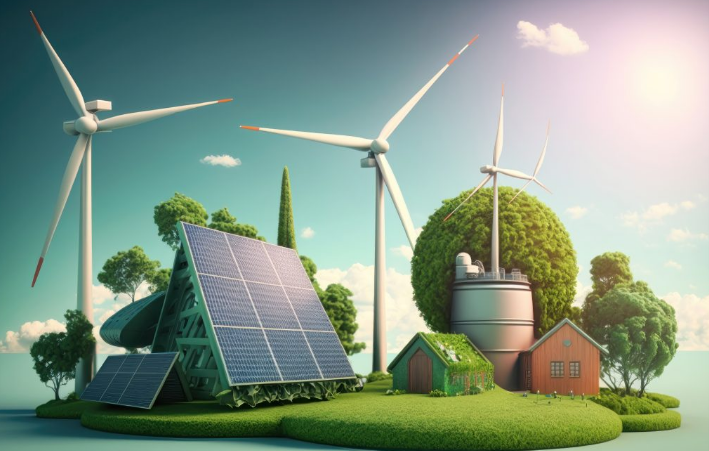The Future of Cleantech and Energy Services in 2024: Innovations and Investments
The cleantech and energy services sectors are at the forefront of the global push towards sustainability and carbon neutrality. In 2024, significant trends and innovations are driving the industry forward, fueled by technological advancements, increased investments, and a growing commitment to environmental responsibility.
1. Rising Investments in Cleantech
Investment in cleantech has seen a significant uptick in 2024, with global energy investments increasingly directed towards renewable energy, energy storage, and low-carbon technologies. A key factor driving this trend is the growing recognition of cleantech as not just an environmental imperative but also a lucrative business opportunity.
For instance, BBVA, a major global financial institution, has set ambitious targets to channel over €300 billion into sustainable business by 2025, with a substantial portion of this funding directed towards cleantech and renewable energy projects. The firm has already mobilized €252 billion, demonstrating the strong momentum in project finance, particularly in renewable energy and energy efficiency initiatives (Home of Sustainability News).
Additionally, global energy supply spending is projected to increase by 20% between 2024 and 2030, with cleantech and grid innovations capturing a significant share of this investment. This surge in capital is expected to accelerate the deployment of renewable energy technologies and infrastructure, including solar, wind, and energy storage solutions (CleanTechIQ).
2. Advancements in Solar and Wind Energy
Solar and wind energy continue to dominate the cleantech landscape, with significant technological advancements and increased capacity. In 2024, solar and wind power are projected to account for nearly 50% of capacity and 30% of electricity generation in Europe, underscoring their critical role in the energy transition.
One of the most notable trends in solar energy is the increasing competition among manufacturers, leading to innovations in efficiency and cost reduction. However, this competition has also resulted in challenges such as oversupply and price wars, particularly in the solar and energy storage markets. Despite these challenges, the sector remains robust, with record offshore wind capacity auctions expected to reach new heights in 2024 (Trellis).
3. The Rise of Low-Carbon Hydrogen
Low-carbon hydrogen is emerging as a key player in the energy transition, offering a versatile solution for decarbonizing various sectors, including heavy industry and transportation. In 2024, there is growing interest in hydrogen as a feedstock, driven by technological advancements and supportive government policies.
The development of hydrogen infrastructure, including production, storage, and distribution networks, is crucial to scaling this technology. Investments in hydrogen are expected to rise, as industries seek to reduce their carbon footprint and meet stringent emissions targets. This trend highlights the importance of innovation in cleantech, as companies explore new ways to produce and utilize hydrogen efficiently (Trellis).
4. Challenges and Opportunities in the Cleantech Sector
While the cleantech sector is poised for growth, it also faces significant challenges. The rising capital costs associated with renewable energy projects, coupled with the complexities of scaling new technologies, present obstacles that must be addressed. Additionally, the sector is navigating regulatory uncertainties and intellectual property (IP) hurdles, particularly for European cleantech companies expanding into international markets like the U.S. (CleanTechIQ).
Despite these challenges, the cleantech industry offers substantial opportunities for innovation and investment. Companies that can navigate these obstacles and leverage technological advancements will be well-positioned to lead the global energy transition. The increasing focus on sustainable finance and corporate responsibility is also driving growth, as investors seek to align their portfolios with climate goals and environmental, social, and governance (ESG) standards (Home of Sustainability News).
5. The Future of Energy Services
Energy services are evolving rapidly, with a focus on enhancing energy efficiency, integrating renewable energy sources, and optimizing grid management. The deployment of smart grids, advanced metering infrastructure, and distributed energy resources is transforming how energy is generated, distributed, and consumed.
In 2024, the adoption of energy storage technologies is playing a crucial role in balancing supply and demand, particularly as renewable energy sources become more prevalent. Energy storage solutions, such as batteries and pumped hydro, are essential for maintaining grid stability and ensuring a reliable energy supply.
Moreover, the integration of digital technologies, including AI and IoT, is enabling more efficient energy management. These technologies provide real-time insights into energy consumption patterns, allowing utilities and consumers to optimize energy use and reduce costs. The continued development of these digital tools will be key to enhancing the performance and sustainability of energy systems (spglobal) (CleanTechIQ).
Conclusion
The cleantech and energy services sectors are at a critical juncture in 2024, with significant advancements and investments driving the global energy transition. From the rise of low-carbon hydrogen to the growth of solar and wind energy, the industry is evolving rapidly to meet the challenges of climate change and environmental sustainability.
While the sector faces obstacles, including rising capital costs and regulatory complexities, the opportunities for innovation and growth are substantial. As investments in cleantech continue to rise and new technologies are developed, the future of energy services looks promising, with the potential to create a more sustainable and resilient global energy system.
Companies and investors that embrace these trends and invest in sustainable solutions will not only contribute to a greener future but also benefit from the economic opportunities that come with leading the energy transition.

